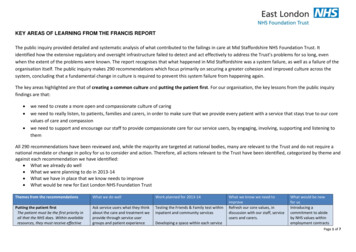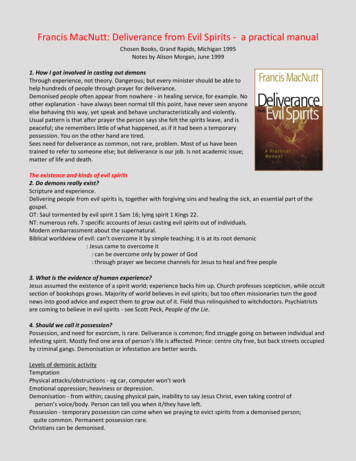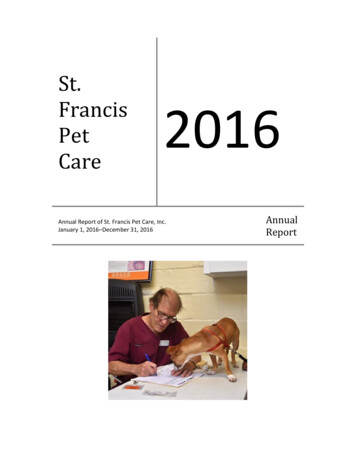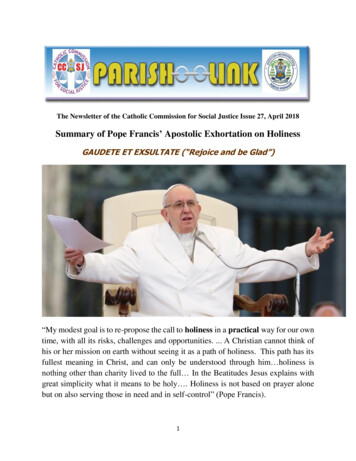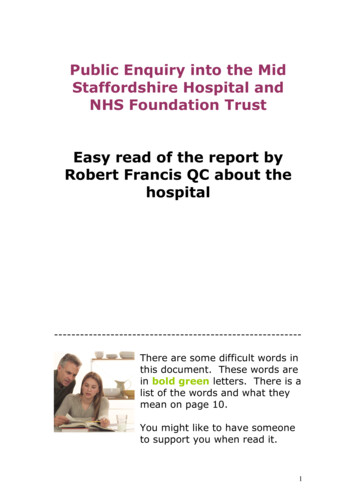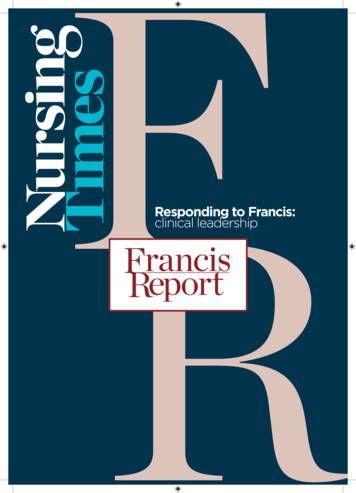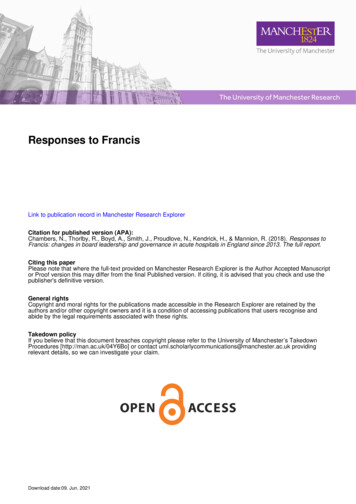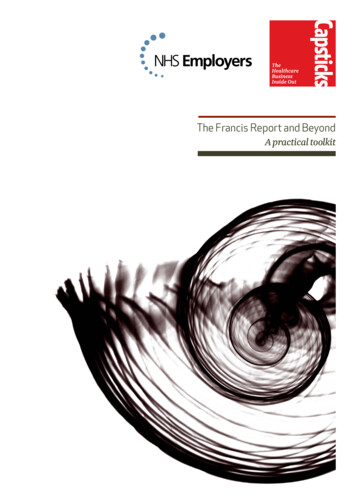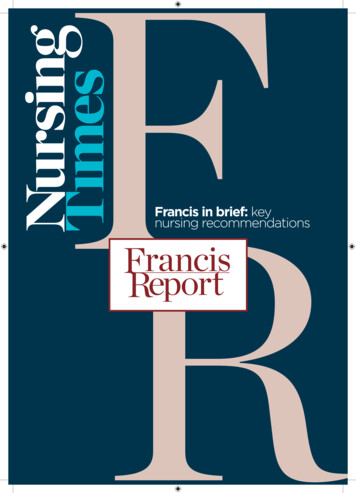
Transcription
Francis in brief: keynursing recommendations
Nursing PracticeBriefingCultureKeywords: Safety culture/StaffordHospital/Francis report/RecommendationsThe Mid Staffs inquiry said the NHS has a “negative, uncaring culture”.Robert Francis has made recommendations on how this can be addressedNT RESPONSEChanging the cultureof the health serviceIn this article. hat the inquiry found at Mid Staffordshire trustW Recommendations for future practiceFor many years there has been anemphasis on the development ofnurses as leaders, culminating inthe development of the Leadership Framework and the NHS LeadershipAcademy in 2012.Robert Francis QC has called for a changein culture within the NHS (Francis, 2013).Several witnesses involved in the Mid Staffordshire Foundation Trust public inquirymade reference to a negative and uncaringculture that was detrimental to patient care.Mr Francis’ response to this is to propose a“common culture” throughout the NHS.However, he acknowledges simply recommending staff change their behaviour isunlikely to be successful. The report suggests several areas where improvements canbe made as well as actions to take to ensurepositive values and ways of doing thingsare common throughout the organisation.In addition to developing a caring, committed and compassionate outlook, thereport places emphasis on the creation of a“safety culture”. This refers to a culturethat aspires to cause no harm and to provide adequate, and, where possible, excellent care and treatment.SPLWhere things went wrongIt is clear that a safety culture did not prevail at Stafford hospital (Box 1). The reportsuggests three reasons why:» “Denial of injury”, believing that thingsare not as bad as they seem;» “Denial of responsibility”, believing theproblems are due to a lack of resourcesand that nothing can be done;» “Condemning the condemners”, seeingcriticisms as coming from people whodo not fully understand the situation.During the inquiry into Stafford Hospital and the wider trust, Mr Francisexposed several areas where a compassionate, safety culture was not upheld.Hospital board meetings were conducted privately with no one outside of theboard being involved in the discussion. MrFrancis points out the content of the meetings is of public interest and suggests thissecrecy creates misplaced trust, particularly surrounding finance and the benefitsof becoming a foundation trust.The poor standards at the hospital werelargely tolerated – the peer-review processhighlighted several specific deficiencieswithin the critically ill and injured children’s services. These were recognised inthe peer-review report, but no steps weremade to rectify them.There was a general assumption withinthe trust that the matters of concern wereno different from what was happening atother trusts. Mr Francis notes that thisattitude “can lead to the comforting conclusion that more cannot be done”.Patients were not put first and care wasnot patient-centred. Staff numbers werereduced and the skill mix diluted withoutassessment of the risk this may pose topatients. Mr Francis notes that concernsabout patient safety were raised but littleor no action was taken and there tended tobe a focus on coding rather than on patientcare. He attributes the “relentless drive toreach foundation trust status” as being acause of the willingness to play downsafety concerns, continuing to run services known to be deficient and prioritybeing given to confidentiality and supportof colleagues and organisations over theduty to warn others of safety risks.16 Nursing Times 19.02.13/ Vol 109 No 7 / www.nursingtimes.net5 keypoints1A “commonculture” hasbeen proposedthroughout the NHSThe reportplaces emphasison the creation of a“safety culture”An organisationshould haveshared values fromtop management tofrontline staffThe NHS musthave strong,consistentleadership tomotivate staffEveryoneemployed bythe NHS shouldhave a “questioningattitude, a rigorousapproach and goodcommunicationskills”2345Managers shouldspend more timeon wards
“A caring and compassionatenature is the cornerstoneof every good nurse”Jane RobinsonBox 1. CulturalproblemsCultural themes identified include: Bullying Target-driven priorities Disengagement from management Low staff morale Isolation Lack of candour Acceptance of poor behaviours Reliance on external assessments DenialHow is a safety culture achieved?Calling on evidence from organisationswith a positive culture, Mr Francis identified key factors that are vital for a compassionate, safety culture to exist. In particular,having shared values throughout theorganisation, from top management tofrontline staff. For this to work, the NHSmust have strong, consistent leadership tomotivate staff as well as ensure everyoneunderstands and supports objectives. MrFrancis stresses this change must comefrom the top and leaders need to have directcontact with frontline staff where they canreinforce the safety culture message.All staff need a “questioning attitude, arigorous approach and good communication skills”. When errors are reported, thisshould be seen as a “learning opportunity”rather than a punishable offence.The report reinforces the idea of“patient-centred” care and suggests everyone with any involvement with a patientshould take personal responsibility formaking sure everything they do is for thebenefit of the patient, and this attitudeshould be recognised and rewarded.There should be less tolerance of lowstandards; the inquiry found that errorsand potential hazards were frequentlyhighlighted but as those responsible statedthey were in the process of making changes,no action was taken. Ideally, if a service isfound to be providing poor care, the moderator should take immediate action; thiscould include closing a service if the necessary resources are not available to run itsafely. Less tolerance also refers to individuals who persistently underperform so thatproviding poor care has negative consequences for individuals. Conversely, thoseproviding exceptional care should be recognised and rewarded for doing so.The report stated that throughout theNHS there are frequent ward-level changesand new objectives being introduced. Thisresults in wards not having enough time top28achieve objectives and as such not feelingmotivated to do so. It is suggested “less radical solutions” should be used where possible to meet the same ends.In order to promote an open and honestculture, the report suggests information onoutcomes, such as patient experience andsatisfaction, should be openly available toanyone who wants to view it including thepublic. Patients should also be able toaccess other relevant information such asthe performance record of their surgeon.Francis report recommendationsMr Francis has made several direct recommendations to bring the culture of theNHS in line.On admission, patients should be giveninformation, both orally and in writtenform, that relates directly to their care. Thiswill include: the reason for the admission,plan of treatment and when this willhappen, the names of those responsible forcare, contact details for leaders of the care,the approach to sharing information withfriends/family and so on, which willinclude a list of all those authorised by thepatient to have access to information.All patients should also be given general information, again both orally andwritten, concerning the hospital and ward.This will include: ward layout, the standards the patient can expect, how help canbe summoned, the ward routine/timetable, visiting restrictions and reasoningfor them, information about securestorage, a list of staff working on the wardand an explanation of what the differentuniforms mean and how to raise concerns.All staff should wear clearly displayedname badges stating their role andBox 2. What is“culture”?Charles Vincent, professor of clinicalsafety research at Imperial College,London, defines the term“organisational culture” within the BMJas having the following characteristics: Shared basic assumptions Discovery, creation or development ofthose assumptions by a defined group Group learning of how to cope withits problem of external adaptation andinternal integration Identification of ways that have workedwell enough to be considered valid Teaching new members of the groupthe correct way to perceive think andfeel in relation to any problemsseniority level. To make it easier forpatients and visitors to know the role ofthe person they are speaking to, staff members of different levels and roles shouldwear clearly distinguishable uniforms.All staff should communicate in afriendly manner and offer help as needed.If it is not possible to help, they should givethe patient a reasonable explanation anddo everything within their means to ensurethe patient’s needs are attended to. Every-one working on the ward is responsiblefor keeping it clean and should remindothers of the handwashing policy.Where the patient has authorised them,staff should freely interact with visitorsand allow them to be included in the care,for example help with feeding.Staff on all shifts, including nights,should have up-to-date knowledge ofpatient care plans. All disciplines shouldalso be involved in all aspects of patients’care and be present at review meetings.Nutrition and hydration is the responsibility of all staff; everyone should be identifying if a patient needs help with feedingand taking steps to ensure they receive it.All members of the multidisciplinary teamshould recognise the importance of nutrition and ensure treatment does not coincide with mealtimes.Evidence-based, standardised procedures, for example surgical checklists, areto be widely used so that care is consistent.If any member of staff thinks a discharge is inappropriate or unsafe theyshould be empowered to voice their concerns without being criticised. All incidents of concern should be reported andthese reports responded to.Statistics and performance reportsshould be easily understood and widelyavailable and should be compared betweendifferent wards and departments. Regularappraisals should reflect these reports andbe mandatory, with emphasis placed onthese being genuinely useful for professional development and including peerreview. Staff need to be willing to both giveand accept constructive criticisms.Top managers should spend more timeon wards and interacting with frontlinestaff to give them a better picture of how thewards are run. Managers can then use reallife examples of care in meetings anddevelop more patient-centred strategies. NTFran Entwistle is assistant practice andweb editor at Nursing TimesReferenceFrancis R (2013) Report of the Mid StaffordshireNHS Foundation Trust Public Inquiry. London: TheStationery office. tinyurl.com/HMSO-Francis2www.nursingtimes.net / Vol 109 No 7 / Nursing Times 19.02.13 17
Nursing PracticeReviewFrontline careKeywords: Francis report/Frontlinecare/Key nurse/Ward roundOrganisations should introduce key nurse roles so that, over thecourse of a shift, patients have one nurse who is their main port of callNT RESPONSEHow nurses can leadfrom the frontlineIn this article. hat the Francis report says about frontline nursingW The role of the key nurse Ward rounds as a central point of communicationIn his inquiry into Mid StaffordshireFoundation Trust, Robert Francis QCidentified what he describes as “a completely unacceptable standard ofnursing care” (Francis , 2013). From the evidence given to the inquiry he concludedthat the decline in standards was associated with inadequate staffing levels andskills, as well as a lack of effective leadership and support.To address this, Mr Francis has madeseveral recommendations on changes tothe way nurses work in order to improvethe quality of care offered by frontlineNHS staff.Recommendations“Key nurses” should be responsible forcoordinating provision of careThe report recommends that patientsshould be allocated key nurses on a shiftby-shift basis to ensure that patients havea specific nurse who is responsible fortheir care at all times. A lack of someone totake direct responsibility for the provisionof care was one of the main failings foundat Mid Staffs. This differs from the “namednurse” or “key worker” role, wherebypatients are assigned to a nurse for theduration of their admission. Instead,nurses will be allocated at the start of eachshift as the main port of call for a patientand their family.Key nurses would have to accompanydoctors during ward rounds and any otherinteraction with their allocated patients.This will keep nurses updated on everything that is happening and allow them tocommunicate decisions and progress confidently to patients and family members.Nurses’ role in ward rounds to beextendedThis recommendation relates to nursesacting as “a central point of communication between the patient and medicalstaff ”. Mr Francis wants senior nurses tobe in attendance at all ward rounds so thesenior nursing team are kept informed of,and have a say in, all key decisions.As well as improving communicationbetween medical and nursing teams, thisrecommendation aims to place nurses in aposition where they are better able to advocate on behalf of patients. Nurses are likelyto spend more time with patients thanother members of the multidisciplinaryteam so they need to be present to pass oninformation from the preceeding 24 hoursof the patient’s care that only the nursingstaff will know.The initial inquiry found that oftenthere were difficulties in locating nurseswho were available to attend ward rounds.Mr Francis argues that nurses’ activeinvolvement in ward rounds is essentialto be incorporated into best practice, andthat a nurse should always be present.He also stresses the importance of fulland comprehensive handovers betweenshifts and to the rest of the multidisciplinary team.All members of the multidisciplinaryteam to prioritise ward roundsThis recommendation is inspired by apublication from Royal College of Physician
Francis report recommendations Mr Francis has made several direct recom-mendations to bring the culture of the NHS in line. On admission, patients should be given information, both orally and in written form, that relates directly to their care. This will include: the reason for the admission, plan of treatment and when this will happen, the names of those responsible for care, contact details .File Size: 656KBPage Count: 8
